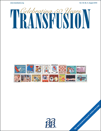Impact of cytomegalovirus (CMV) antibody reflex testing in the transfusion service on management of CMV-seronegative blood inventory
Abstract
BACKGROUND: Our goal is to minimize unnecessary cytomegalovirus (CMV)-seronegative blood transfusion to preserve the CMV-seronegative blood inventory for patients who are identified as CMV seronegative.
STUDY DESIGN AND METHODS: We implemented a CMV antibody reflex testing protocol for patients who require CMV-compatible blood but in whom a CMV serostatus is unknown (coded as CMVT in our computer system). A solid-phase red blood cell (RBC) adherence antibody detection system was validated to detect CMV antibodies in plasma samples (received for ABO/Rh type and RBC antibody screen) with acceptable sensitivity and specificity. We evaluated the impact of this CMV antibody reflex testing on the management of RBC and platelet (PLT) inventory for patients requiring CMV-compatible blood.
RESULTS: Over a 16-month period, implementation of CMV antibody reflex testing identified 361 (34%) of 1063 previously CMV-untested patients who required CMV-compatible blood and who were CMV seronegative. We observed a 75% decrease in the number of CMVT patients in our data base from 190 per month before implementation to 57 at 16 months postimplementation. Consequently we reevaluated the percentage in our blood inventory of CMV-seronegative units required while potentially saving 1234 CMV-seronegative blood products (835 RBCs and 399 PLTs) each month.
CONCLUSION: A strategy of performing CMV antibody reflex testing in the transfusion service allows more effective blood inventory management and control in maintaining a CMV-seronegative blood inventory dedicated for patients who truly require it.




